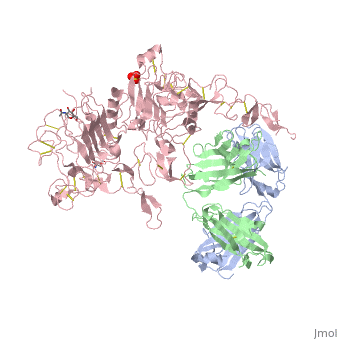1n8z
From Proteopedia
Crystal structure of extracellular domain of human HER2 complexed with Herceptin Fab
Structural highlights
DiseaseERBB2_HUMAN Defects in ERBB2 are a cause of hereditary diffuse gastric cancer (HDGC) [MIM:137215. A cancer predisposition syndrome with increased susceptibility to diffuse gastric cancer. Diffuse gastric cancer is a malignant disease characterized by poorly differentiated infiltrating lesions resulting in thickening of the stomach. Malignant tumors start in the stomach, can spread to the esophagus or the small intestine, and can extend through the stomach wall to nearby lymph nodes and organs. It also can metastasize to other parts of the body. Defects in ERBB2 are involved in the development of glioma (GLM) [MIM:137800. Gliomas are central nervous system neoplasms derived from glial cells and comprise astrocytomas, glioblastoma multiforme, oligodendrogliomas, and ependymomas. Defects in ERBB2 are a cause of susceptibility to ovarian cancer (OC) [MIM:167000. Ovarian cancer common malignancy originating from ovarian tissue. Although many histologic types of ovarian neoplasms have been described, epithelial ovarian carcinoma is the most common form. Ovarian cancers are often asymptomatic and the recognized signs and symptoms, even of late-stage disease, are vague. Consequently, most patients are diagnosed with advanced disease. Defects in ERBB2 may be a cause of lung cancer (LNCR) [MIM:211980. LNCR is a common malignancy affecting tissues of the lung. The most common form of lung cancer is non-small cell lung cancer (NSCLC) that can be divided into 3 major histologic subtypes: squamous cell carcinoma, adenocarcinoma, and large cell lung cancer. NSCLC is often diagnosed at an advanced stage and has a poor prognosis. Defects in ERBB2 are a cause of gastric cancer (GASC) [MIM:613659. A malignant disease which starts in the stomach, can spread to the esophagus or the small intestine, and can extend through the stomach wall to nearby lymph nodes and organs. It also can metastasize to other parts of the body. The term gastric cancer or gastric carcinoma refers to adenocarcinoma of the stomach that accounts for most of all gastric malignant tumors. Two main histologic types are recognized, diffuse type and intestinal type carcinomas. Diffuse tumors are poorly differentiated infiltrating lesions resulting in thickening of the stomach. In contrast, intestinal tumors are usually exophytic, often ulcerating, and associated with intestinal metaplasia of the stomach, most often observed in sporadic disease. Note=Chromosomal aberrations involving ERBB2 may be a cause gastric cancer. Deletions within 17q12 region producing fusion transcripts with CDK12, leading to CDK12-ERBB2 fusion leading to truncated CDK12 protein not in-frame with ERBB2. FunctionERBB2_HUMAN Protein tyrosine kinase that is part of several cell surface receptor complexes, but that apparently needs a coreceptor for ligand binding. Essential component of a neuregulin-receptor complex, although neuregulins do not interact with it alone. GP30 is a potential ligand for this receptor. Regulates outgrowth and stabilization of peripheral microtubules (MTs). Upon ERBB2 activation, the MEMO1-RHOA-DIAPH1 signaling pathway elicits the phosphorylation and thus the inhibition of GSK3B at cell membrane. This prevents the phosphorylation of APC and CLASP2, allowing its association with the cell membrane. In turn, membrane-bound APC allows the localization of MACF1 to the cell membrane, which is required for microtubule capture and stabilization.[1] [2] [3] [4] [5] [6] In the nucleus is involved in transcriptional regulation. Associates with the 5'-TCAAATTC-3' sequence in the PTGS2/COX-2 promoter and activates its transcription. Implicated in transcriptional activation of CDKN1A; the function involves STAT3 and SRC. Involved in the transcription of rRNA genes by RNA Pol I and enhances protein synthesis and cell growth.[7] [8] [9] [10] [11] [12] Evolutionary ConservationCheck, as determined by ConSurfDB. You may read the explanation of the method and the full data available from ConSurf. Publication Abstract from PubMedHER2 (also known as Neu, ErbB2) is a member of the epidermal growth factor receptor (EGFR; also known as ErbB) family of receptor tyrosine kinases, which in humans includes HER1 (EGFR, ERBB1), HER2, HER3 (ERBB3) and HER4 (ERBB4). ErbB receptors are essential mediators of cell proliferation and differentiation in the developing embryo and in adult tissues, and their inappropriate activation is associated with the development and severity of many cancers. Overexpression of HER2 is found in 20-30% of human breast cancers, and correlates with more aggressive tumours and a poorer prognosis. Anticancer therapies targeting ErbB receptors have shown promise, and a monoclonal antibody against HER2, Herceptin (also known as trastuzumab), is currently in use as a treatment for breast cancer. Here we report crystal structures of the entire extracellular regions of rat HER2 at 2.4 A and human HER2 complexed with the Herceptin antigen-binding fragment (Fab) at 2.5 A. These structures reveal a fixed conformation for HER2 that resembles a ligand-activated state, and show HER2 poised to interact with other ErbB receptors in the absence of direct ligand binding. Herceptin binds to the juxtamembrane region of HER2, identifying this site as a target for anticancer therapies. Structure of the extracellular region of HER2 alone and in complex with the Herceptin Fab.,Cho HS, Mason K, Ramyar KX, Stanley AM, Gabelli SB, Denney DW Jr, Leahy DJ Nature. 2003 Feb 13;421(6924):756-60. PMID:12610629[13] From MEDLINE®/PubMed®, a database of the U.S. National Library of Medicine. See AlsoReferences
| ||||||||||||||||||||


